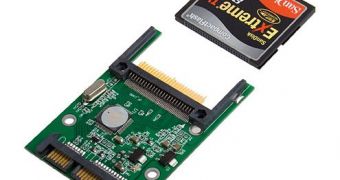Solid-state drives are not only sexy, faster or energy-aware, they are also expensive, and many times, getting such a drive will merely pierce through your budget. However, given the fact that everybody is talking about the new frenzy in the storage world, you might want to give it a try.
While solid-state drives come with insane price tags for almost ridiculous capacities ($600 to $1,000 for sub-32GB versions), a cheaper alternative will be using high-capacity flash cards. However, the flash cards cannot be directly connected to the computer otherwise than using an USB multimedia card reader. Solid-state drives are able to connect via a SATA (or SATA-II) interface, which gives them a significant boost in data transfer rates.
The good news is that compact flash cards can be "convinced" to work via a SATA interface. All you need is to get a cheap Compact Flash to SATA adapter, then add a moderately priced memory card. You can have a solid-state drive setup for less than $100, which is far more affordable than a fully-fledged SSD device.
The good thing about such drives is that they do not ask for additional drivers; they just work out-of-the-box. However, in order to successfully install the above-mentioned SSD-wannabe into your computer, your motherboard must have a Serial-ATA connector. Moreover, the Compact Flash card must support DMA (direct memory access) modes. A compact flash card that offers 4GB of storage or even more will surely do the job.
Right after the physical installation inside your rig, you can proceed to install the operating system. 4GB of drive space will allow you to run any version of Windows XP. Microsoft's Windows Vista could also work on 4GB of drive space, but it requires additional efforts (you'll have to strip down all the unnecessary features, in order to fit it on 4GB). Using an 8GB compact flash card will allow you to install Vista without any problems.
The Compact Flash card is not quite as fast as single-level cell flash, and has slightly lower disk transfer rates than a normal, 7200 RPM hard disk drive. However, the compact-flash replacement will do just fine inside a laptop system, and would allow you to give it a serious shake while running without losing all your stored data.

 14 DAY TRIAL //
14 DAY TRIAL //